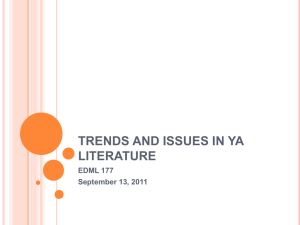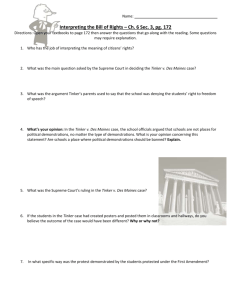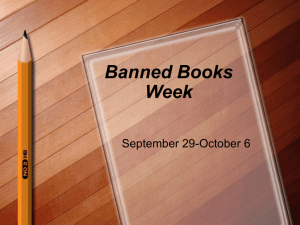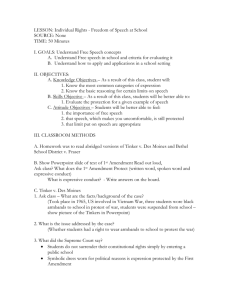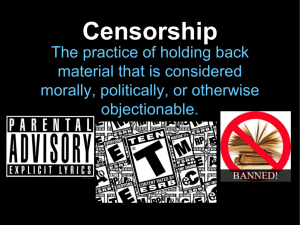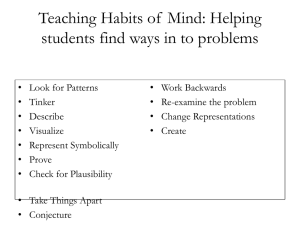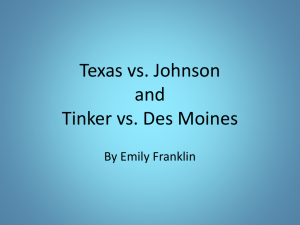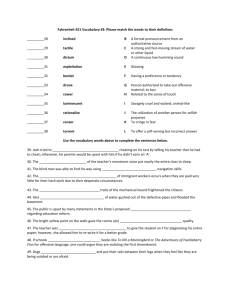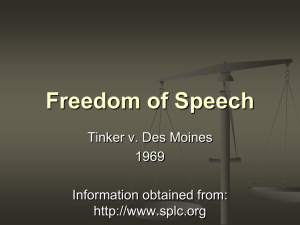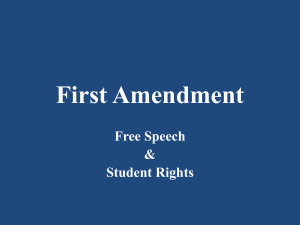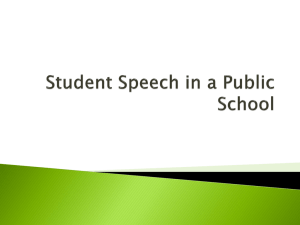Banned Books - Northern Illinois University
advertisement
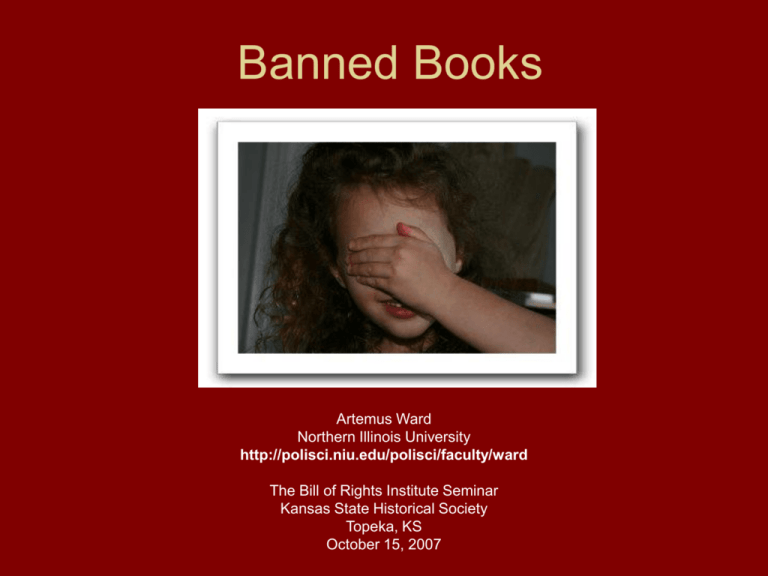
Banned Books Artemus Ward Northern Illinois University http://polisci.niu.edu/polisci/faculty/ward The Bill of Rights Institute Seminar Kansas State Historical Society Topeka, KS October 15, 2007 The Question • Can public schools ban certain books from junior high and high school libraries, based on their content? • Does this violate the First Amendment's freedom-ofspeech protections? Schoolhouse Rights • In Meyer v. Nebraska (1923), the U.S. Supreme Court struck down a state law that forbade the teaching of modern foreign languages in public and private schools. • In West Virginia Board of Education v. Barnette (1943), the Court held that under the First Amendment a student in a public school could not be compelled to salute the flag. • In Epperson v. Arkansas (1968), the Court struck down as a violation of the Establishment Clause a state law that prohibited the teaching of the Darwinian theory of evolution in any state-supported school. • But these cases dealt with required curriculum and not optional, library books. Tinker v. Des Moines (1969) • John Tinker, 15, was a student at a public high school in Des Moines, Iowa. Mary Beth Tinker, his 13year-old sister, attended junior high school. After meeting with a group of adults and students, they decided to publicize their objections to the Vietnam War by wearing black armbands to school. School authorities became aware of the plan and adopted a policy that any student wearing an armband would be asked to remove it; if the student refused, the student would be suspended until he or she returned to school without the armband. The Tinker children wore armbands and were suspended from school. Tinker v. Des Moines (1969) • Do students have the right to political expression on school grounds? • Does the state have the authority to restrict speech under its police powers: protect the health, safety, welfare, and morals of the people? • Is there a difference between elementary, middle, high school, and college students for free speech purposes? Tinker v. Des Moines (1969) • Justice Fortas wrote for the Court: • “In order for the state, in the person of school officials, to justify prohibition of a particular expression of opinion, it must be able to show that its action was caused by something more than a mere desire to avoid the discomfort and unpleasantness that always accompany an unpopular viewpoint.” • “comprehensive authority ... of school officials” must be exercised “consistent with fundamental constitutional safeguards.” • Students do not “shed their constitutional rights when they enter the schoolhouse door.” Tinker v. Des Moines (1969) • The Court ruled that this symbolic speech--"closely akin to pure speech"--could only be prohibited by school administrators if they could show that it would cause a substantial disruption of the school's educational mission. • The school allowed other forms of political expression such as Nixon and Humphrey campaign button and the Iron Cross. • School isn’t just about attending classes and learning prescribed material. It is also about intercommunication among the students. Students Are Not Adults • Despite the progressive language of Tinker, several Supreme Court cases have established that students in public schools generally do not have the same rights as adults. They have fewer rights to free speech, privacy, and other liberties. • The question is how to balance children’s rights to receive information with educators’ and parents’ concern about the suitability of certain materials. Board of Ed., Island Trees School Dis. v. Pico (1982) • • • In 1976, a New York school board decided to pull a number of books from library shelves in response to a complaint by community group, Parents of New York United. The group said the books were “anti-American, antiChristian, anti-Semitic and just plain filthy” and concluded that "[i]t is our duty, our moral obligation, to protect the children in our schools from this moral danger as surely as from physical and medical dangers.“ The books in the High School library were: – – – – – – – – – – – Slaughterhouse Five, by Kurt Vonnegut, Jr.; The Naked Ape, by Desmond Morris Down These Mean Streets, by Piri Thomas; Best Short Stories of Negro Writers, edited by Langston Hughes; Go Ask Alice, of anonymous authorship; Laughing Boy, by Oliver LaFarge; Black Boy, by Richard Wright; A Hero Ain't Nothin' But A Sandwich, by Alice Childress; Soul On Ice, by Eldridge Cleaver; A Reader for Writers, edited by Jerome Archer (Junior High library); The Fixer, by Bernard Malamud (included in the curriculum of a twelfth-grade literature course). Board of Ed., Island Trees School Dis. v. Pico (1982) • A plurality of the justices ruled against the Board on First Amendment grounds. Justice William Brennan (with Marshall, Stevens, and Blackmun) held that the right to read—or receive ideas—is implied by the First Amendment. The government, in the form of “local school boards may not remove books from school library shelves simply because they dislike the ideas contained in those books.” • Brennan called libraries places for “voluntary inquiry” and concluded that unlike required curriculum, the school board’s “absolute discretion” over the classroom did not extend to the library for that reason. Board of Ed., Island Trees School Dis. v. Pico (1982) • • • Chief Justice Warren Burger (with Powell, Rehnquist, and O’Connor), dissenting: “a plurality of the Court, in a lavish expansion going beyond any prior holding under the First Amendment, expresses its view that a school board's decision concerning what books are to be in the school library is subject to federal-court review. Were this to become the law, this Court would come perilously close to becoming a "super censor" of school board library decisions. Stripped to its essentials, the issue comes down to two important propositions: first, whether local schools are to be administered by elected school boards, or by federal judges and teenage pupils; and second, whether the values of morality, good taste, and relevance to education are valid reasons for school board decisions concerning the contents of a school library. In an attempt to place this case within the protection of the First Amendment, the plurality suggests a new "right" that, when shorn of the plurality's rhetoric, allows this Court to impose its own views about what books must be made available to students.” “If the school can set curriculum, select teachers, and determine what books to purchase for the school library, it surely can decide which books to discontinue or remove from the school library.” Frequently Challenged Books • • • • • • • • • • • • Obscenity was not at issue in Pico, but is often used to challenge books. The American Library Association (ALA) collects data and publishes lists of the most frequently challenged books. Between 1990 and 2000, there were 6,364 challenges reported to or recorded by the ALA: 1,607 were challenges to “sexually explicit” material; 1,427 to material considered to use “offensive language”; 1,256 to material considered “unsuited to age group”; 842 to material with an “occult theme or promoting the occult or Satanism”; 737 to material considered to be “violent”; 515 to material with a homosexual theme or “promoting homosexuality,” 419 to material “promoting a religious viewpoint.” Other reasons for challenges included “nudity” (317 challenges), “racism” (267 challenges), “sex education” (224 challenges, and “anti-family” (202 challenges). Seventy-one percent of the challenges were to material in schools or school libraries. Another twenty-four percent were to material in public libraries. Sixty percent of the challenges were brought by parents, fifteen percent by patrons, and nine percent by administrators. Top Ten Challenged Authors (1990-2004) 1. Alvin Schwartz 2. Judy Blume 3. Robert Cormier 4. J.K. Rowling 5. Michael Willhoite 6. Katherine Paterson 7. Stephen King 8. Maya Angelou 9. R.L. Stine 10. John Steinbeck Top Ten Most Challenged Books (2006) 1. “And Tango Makes Three” by Justin Richardson and Peter Parnell, for homosexuality, anti-family, and unsuited to age group; 2. “Gossip Girls” series by Cecily Von Ziegesar for homosexuality, sexual content, drugs, unsuited to age group, and offensive language; 3. “Alice” series by Phyllis Reynolds Naylor for sexual content and offensive language; 4. “The Earth, My Butt, and Other Big Round Things” by Carolyn Mackler for sexual content, anti-family, offensive language, and unsuited to age group; 5. “The Bluest Eye” by Toni Morrison for sexual content, offensive language, and unsuited to age group; 6. “Scary Stories” series by Alvin Schwartz for occult/Satanism, unsuited to age group, violence, and insensitivity; 7. “Athletic Shorts” by Chris Crutcher for homosexuality and offensive language; 8. “The Perks of Being a Wallflower” by Stephen Chbosky for homosexuality, sexually explicit, offensive language, and unsuited to age group; 9. “Beloved” by Toni Morrison for offensive language, sexual content, and unsuited to age group; 10. “The Chocolate War” by Robert Cormier for sexual content, offensive language, and violence. • Off the list this year, but on for several years past, are the “Catcher in the Rye” by J.D. Salinger, “Of Mice and Men” by John Steinbeck and “The Adventures of Huckleberry Finn” by Mark Twain. • Note: Data based on 546 challenges analyzed by ALA. Conclusion • The U.S. Supreme Court’s inability to provide clear guidelines in this area, coupled with the general principle of state/local/community control of education, have resulted in continuing challenges to library books in public schools. • Unless the Supreme Court decides to take another bookbanning case, the issue will at best be decided regionally by the various U.S. Courts of Appeals.
